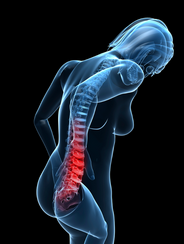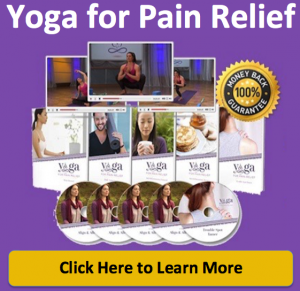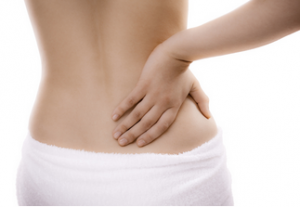Science Validates Benefits of Yoga for Back Pain

According to an article published in Consumer Affairs this month, 125 million people are in pain and spending $300 billion to find relief. If you’re one of those people suffering, you’ve probably had enough. But there is light at the end of the pain tunnel — an alternative to pain meds, expensive treatments, and temporary fixes — it’s called yoga.
If you haven’t looked into it yet, it’s time to consider the benefits of yoga for your chronic back pain so you can eliminate the pain and take back your life. Its many claims of balancing emotional, physical, and spiritual health have been asserted for decades but are now finally being substantiated — which is interesting considering yoga is an ancient practice that’s been associated with cultural, religious, and physical activity for more than 2,000 years. Yep, 2,000 years. That’s a long time.
If you think about that history, it’s kind of astonishing it’s taken so long to begin researching yoga’s many benefits for pain. Still, in the last 10 or so years, the evidence has started to pile up. For the purposes of this article however, we’re not going to bury you in study after study or research paper after research paper, but we do want to scratch the surface. So let’s get to it, shall we?
What does the science say?
In a time when technology and drugs have dominated the way we live our lives, it’s quite refreshing to see yoga is finally getting the accolades it deserves as a form of treatment. According to the National Health Interview Survey (NHIS, 2007), which included a comprehensive survey on the use of complementary health approaches by Americans, yoga is the sixth most commonly used complementary health practice among adults.
According to the National Center for Complementary and Integrative health (NIH), a carefully adapted set of yoga poses may reduce low-back pain and improve function. Other studies have also suggested that practicing yoga (as well as other forms of regular exercise) may improve quality of life; reduce stress; lower heart rate and blood pressure; help relieve anxiety, depression, and insomnia; and improve overall physical fitness, strength, and flexibility. Wow, that’s quite a list. Even if it only did a few of those, that’s a strong case for yoga already.
“…Yoga is the sixth most commonly used complementary health practice among adults.”
In the management of back pain, the first reports of success came with small group studies published in 2004. However, in recent years, large-scale studies have added significant scientific foundation to the utility of yoga in managing pain. In 2012, a study published in Complementary Therapies in Medicine examined the effect of yoga on lower back pain. Dr. Padmini Tekur and colleagues from the Division of Yoga & Life Sciences at the Swami Vivekananda Yoga Research Foundation (SVYASA) in India carried out a seven-day randomized control trial at a holistic health center in Bangalore, India, with 80 patients with chronic lower back pain. They assigned patients to one of two groups — yoga therapy and physical therapy. Their results showed that practicing yoga is more effective than physical therapy at reducing pain, anxiety, and depression, and improving spinal mobility.
A more recent study in 2015 published in the European Journal of Integrative Medicine, found that yoga might be an effective treatment for stress and inflammation in patients with chronic low back pain. Back flexibility significantly improved in the yoga group, and serum cortisol levels decreased significantly.
“…Results showed that practicing yoga is more effective than physical therapy at reducing pain, anxiety and depression, and improving spinal mobility.”
So how exactly does yoga help?
All that information can get… well, a little too sciency. The bottom line is this: your back pain could be related to a lack of strength and flexibility in your core, legs, and lower back. Yoga helps your body develop strength, flexibility, and flow, which are all building blocks to becoming pain free. That means your body needs to do some work. Of course at the onset of an injury you need to to rest and recover, but when you’re dealing with chronic pain, inactivity is not a good thing. And most of us sit for at least eight hours a day.
Add in the time we spend sleeping, resting on the couch, or sitting in the car, and we’re spending more than half the day compromising our backs and continuing the cycle of abuse! You’ve heard the phrase “a body in motion tends to stay in motion.” Well, it’s true. Movement creates strength and flexibility. Your lower back needs to be strong to support all of the major muscle groups surrounding it, and vice versa.
“Yoga helps your body develop strength, flexibility and flow, which are all building blocks to becoming pain free.”
The human body is connected, head to toe. Every muscle, every tendon, every joint is connected to another muscle, joint, tendon, bone… Your body works like a symphony — every part must work in concert for proper movement. Overcoming your back pain permanently only happens by increasing strength, which is why most doctors recommend physical therapy. (But that can get expensive and is not always the most convenient.) The exercises you do should be carefully planned and coordinated to increase flexibility, strength, and sustainable motion.
So what if there was an affordable and structured yoga program designed to do just that? What if you could take complete control of your back pain in less than 30 minutes a day… would you try it?
What is Yoga for Pain Relief and what makes it different?
Yoga for Pain Relief is an affordable and structured yoga program designed to heal and strengthen the body, at your own pace, from the privacy of your own home. It’s efficacy lies in its systematic approach to building from one sequence to the next. These carefully planned sequences help you build the strength and flexibility you NEED to permanently conquer your back pain. Quite simply, this program allows you to move at your own pace, preparing you for the next challenge. As you move through the 12-week program, you will find your days filled with less pain and more freedom.
Science or no science, what’s not to like about that?

